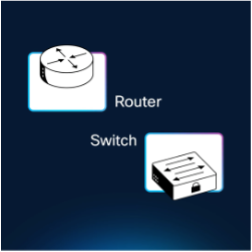Are you breaking into an IT career and diving into networking topics for the first time? You are not alone! As someone studying for the CCST Networking exam, I enjoy my independent study time.
I can learn from anywhere, at any time, and at my own pace. However, being a first-time networking learner has its pros and cons. Since I had little prior knowledge of the topic, I wanted to ensure the content I was learning was clear and understandable.
While independent learning has its advantages, there is also great value in speaking with and learning from others to better grasp complex concepts. This inspired me to create my own CCST Networking Exam video series, “Let’s Break It Down,” where I outline study topics in a quicker and more digestible way.
Episode 1: ‘Let’s Break It Down, CCST Edition’
In this first episode, I cover the main topics found on the CCST Networking exam and provide a quick rundown of what each student needs to study for each topic, including the different
 types of network hardware devices. I will admit, when I first read about networking devices, I thought, “I have my own Wi-Fi box here at home.
types of network hardware devices. I will admit, when I first read about networking devices, I thought, “I have my own Wi-Fi box here at home.
I probably know everything about what a router is and which cable goes where to make it work.” Well, I was wrong. The reality is that there is much more to each device and the roles each play in getting your Wi-Fi to work. On the surface, things may seem simple, but in reality, there are many processes happening behind the scenes, which is exactly why I created this series.
Now that you know what this first episode is all about, I wanted to give you an example of the topics covered, specifically one that is foundational for anyone new to networking. Familiarizing ourselves with the different types of network hardware devices lays the foundation for understanding more complex topics within the CCST learning path. Routers, switches, and cables are essential components of every network. When discussing routers, it is important to focus on their primary functions and how they facilitate routing traffic between networks. Here is a brief technical explanation of routers.
Primary functions of a router:
- Path selection: Routers determine the best and most efficient path for forwarding packets to their destination. They use routing protocols, which are also covered in the exam. Note: A packet is a unit of data that contains IP addresses.
- Packet forwarding: After selecting the optimal path, the router forwards the packet from one network to another. By examining the destination IP address, the router knows exactly where to send the packet next.
Security is an integral part of every exam topic. And routers are key to security because they do more than just move data; they also help protect it. Before forwarding a packet, routers can hide private IP addresses from the public internet using the Network Address Translation (NAT) protocol.
Feeling overwhelmed by studying?
If you are new to IT or you are trying to get into IT, don’t worry, I am here for you. Diving into new CCST topics like router functions may feel overwhelming at times. You are most certainly not alone.
I felt hesitant when I first saw the amount of information I would need to learn. The CCST is introductory and not meant to overwhelm you; it is a great way to transition into the mindset of a networking professional without prior hands-on experience.
Although it can sometimes feel like a lot of information, it’s digestible and understandable. And remember: While independent learning is great, it’s important to explore the many resources Cisco provides to support your journey.
Where should you start?
I hope this blog post has provided you with some quick valuable insight into routers as you prep for the CCST Networking exam. Whether you want to learn about a specific topic you might encounter in a question or want a clearer understanding of key concepts, this video series is here to support you.
Check out Let’s Break it Down episodes to learn more about CCST topics like IP addressing, protocols, and much more through this introductory series.
Be sure to visit the Cisco Networking Academy to find free courses and practice exam content to further boost your learning.

